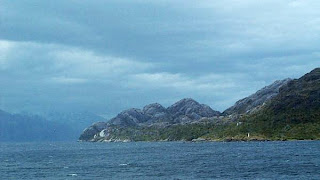 Jiri Snitak. You need to remember that name!
Jiri Snitak. You need to remember that name!Well, we decided before arriving at Punta Arenas, Chile, that we would not be flying to Antarctica. Seeing the frozen continent is one thing, and we look forward to our days of cruising along its coast. Paying $4000 each to step on its soil for a short visit is something else entirely. It seems like you’re paying more for bragging rights than for any experience.
 Torres del Paine National Park, however, attracted us both as an option. Described by some as South America’s finest national park, this has been in existence a bit over fifty years, but still only attracts some 200,000 tourists annually. We would not, of course, have the chance to trek the famous “W” route, but we felt that a visit would introduce us to a new area of Patagonia.
Torres del Paine National Park, however, attracted us both as an option. Described by some as South America’s finest national park, this has been in existence a bit over fifty years, but still only attracts some 200,000 tourists annually. We would not, of course, have the chance to trek the famous “W” route, but we felt that a visit would introduce us to a new area of Patagonia.Zipped by bus to the Punta Arenas airport, our group boarded two prop planes for the hour-long flight inland. We were able to get a few good stills from the plane, which has convinced Sam, at least, of the wisdom of taking local flights wherever possible for a different view of the surroundings. Landing “in the middle of nowhere,” we boarded a bus with Eva, our tour guide, an enthusiastic raconteur with a penchant for “demonstrating” the sexual couplings of the local fauna. Believe us, it was something that had to be seen to be believed ….
 |  |
 |  |
 |  |
 roams in herds here. We even spotted a Patagonian fox! Above all, floating in and out of the clouds and mist are the Torres del Paine. Originally part of a sheep estancia, the Park’s overexploited resources received a further blow in 2005 when a camper using a portable stove
roams in herds here. We even spotted a Patagonian fox! Above all, floating in and out of the clouds and mist are the Torres del Paine. Originally part of a sheep estancia, the Park’s overexploited resources received a further blow in 2005 when a camper using a portable stove in windy conditions, burned down about a tenth of the Park! Think about that for a minute. People are upset about George Bush’s record on the environment and hardly a peep about someone who burned down a tenth of South America’s premier park? So, who was this guy? One of the guide books states that he was a Czech, none name him! Sam decided to do a little footwork and …
in windy conditions, burned down about a tenth of the Park! Think about that for a minute. People are upset about George Bush’s record on the environment and hardly a peep about someone who burned down a tenth of South America’s premier park? So, who was this guy? One of the guide books states that he was a Czech, none name him! Sam decided to do a little footwork and …  (you were wondering who Jiri Snitak was?) So next time somebody asks you about environmental bad guys, you know who to tell them about ….
(you were wondering who Jiri Snitak was?) So next time somebody asks you about environmental bad guys, you know who to tell them about ….The Park is great and well worth a visit, but watch out for deydration. Mary got dehydrated, was sick on the way back, and was out of commission the following day. Still, we both agree that this trip was well worth it!























































